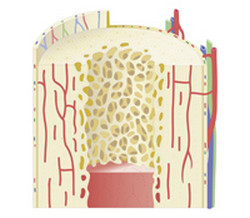Building and analysing bone tissue models
Being able to reproduce bone's phases, organisation and features would have important impact on bone regeneration and prosthetics as well as materials science in general. Scientists did so while providing important insight into synthesis, structure and function with EU support of the project 'Biomimetic organic-inorganic hybrid structural materials' (BIOHYMAT). Through synthesis and study of bone-like materials, the team developed analytical methods important in both clinical and basic research. Bone mineral density (BMD) is a parameter correlated with a number of bone diseases including osteoporosis, osteopetrosis and Paget's Disease. However, there was no method available to measure it with good enough spatial resolution to create accurate BMD maps. The BIOHYMAT approach will be a powerful tool to study the effects of different diseases on BMD and to correlate BMD with mechanical properties of bone. Adhesion at organic/inorganic interfaces plays a significant role in the mechanical response of natural and synthetic composites. Lack of quantitative data has hampered materials selection for hybrid designs. The systematic methodology to study adhesion at organic/inorganic interfaces developed as a result of BIOHYMAT investigations will be an important tool for materials scientists. Researchers went on to develop novel techniques that reproduce the complex hierarchical structure of bone. Manipulating the processing parameters of the freeze casting technique (controlled freezing of water-based particle suspensions), scientists obtained three-dimensional honeycomb and lamellar structures with microporosity. The work paves the way to new opportunities in fabrication of porous ceramics for use in biomedicine, filters and catalyst supports. Finally, investigators ventured into the nanostructured carbon arena with a successful experiment designed to produce hybrid carbon materials. The team synthesised graphene oxide in the laboratory from graphite and demonstrated its reduction to graphene in a vacuum. Both graphene oxide and graphene are novel nanostructured carbon-based materials of great interest for their numerous technological applications. BIOHYMAT made several very important contributions to the field of organic - inorganic hybrid composites with new analytical techniques and novel processing methods. Scientists have provided a jumping board from which they and their colleagues can design and test new materials for emerging applications.
Keywords
Bone, organic – inorganic, hybrid, biomimetic, bone regeneration, prosthetic, bone mineral density, osteoporosis, adhesion, interfaces, freeze casting, graphene

